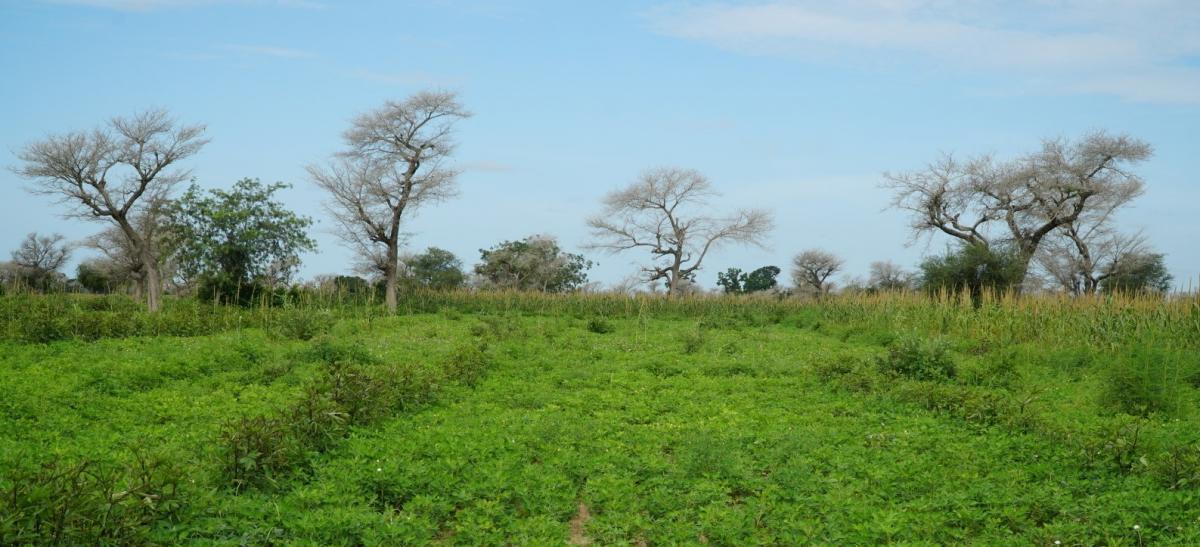Call to action 16 April 2025
- Home
- Press area
- Press releases
- Agroforestry: climate change mitigation potential
Agroforestry can play a key role in the fight against climate change

Groundnut plot within an agroforestry system in the Sahel © C. Dangléant, CIRAD
“We have the know-how and the space to add more trees to global farmlands”, said Drew Terasaki Hart, a Computational Ecologist at TNC and lead author of the study published on 28 September in Nature Climate Change. “Science can help identify the places where agroforestry development has the largest potential for climate change mitigation, while supporting agricultural production and providing multiple other benefits including wildlife habitat.”
Aside from providing substantial climate mitigation potential, agroforestry can also improve crop yields and diversify farm incomes; enhance the sustainability and climate resilience of food production systems; create habitat for biodiversity; and protect people and livestock from extreme heat and other weather events, among other benefits. In regions where agriculture is a major driver of deforestation, such as Brazil, the improved farmer livelihoods that agroforestry practices offer can also help to reduce or even reverse forest loss.
To help achieve the best climate outcomes, the collaborators behind this study came together to identify the critical science gaps currently impeding the deployment of agroforestry practices at scale. The resulting review had three key findings.
First, it showed that even using the best-available estimates from the likes of the IPCC and others, there is still a lack of understanding around:
• how much carbon an individual agroforestry system can hold and how that varies from farm to farm
• where agroforestry currently occurs, suggesting that existing maps overlook some of the most carbon-rich agroforestry systems in the world.
Finally, the review found that agroforestry adoption and ambition are not distributed equally across the world. Whereas certain African countries in particular are at the forefront of global agroforestry efforts, in other regions, there is ample room for expansion of these practices. Despite the enormous potential of agroforestry, there is a need for further research into how to best deploy this natural climate solution in agricultural systems around the world. This is largely due to ambiguity about which agroforestry actions provide carbon mitigation, alongside uncertainty as to their full sequestration potential, and difficulty in tracking the progress of agroforestry practices
Agroforestry comes in many different forms, including a variety of Indigenous, traditional, and modern farming practices – from ancient Roman farmers interlacing their fields with olive trees, to communities in the Amazon Basin combining forest stewardship with small-scale production of lucrative tropical crops like cacao and coffee. “This diversity brings both benefits and challenges,” said senior author Susan Cook-Patton, a Senior Forest Restoration Scientist at TNC. “While this vast menu of options means farmers can more easily find an agroforestry system that will work for them, it also challenges scientists’ ability to determine how much climate mitigation any given system will offer.”
“In many regions, trees have been increasingly removed from farms, especially in the global North” said co-author Rémi Cardinael, a researcher at CIRAD. “Agroforestry could be a smarter way to restore forest to these regions, compared with large scale reforestation projects that may be more vulnerable to disturbance, while also offering more direct benefits to farmers.”
The researchers advocate for farmer-focused steps to accelerate investment in agroforestry for climate mitigation. They stress the need for further research into how to best deploy this natural climate solution in agricultural systems around the world. The researchers are now working to consolidate the information that already exists across thousands of often hard-to-access scientific papers.
“With the world’s land increasingly squeezed by competing demands for food, fibre, and fuel, we need to both produce more food and reduce carbon emissions,” said Fred Stolle, Deputy Director of the Forests programme at World Resources Institute and another co-author on the paper. “Agroforestry is a critical way we can meet both goals at once.”
Reference
Terasaki Hart, D.E., Yeo, S., Almaraz, M. et al. Priority science can accelerate agroforestry as a natural climate solution. Nat. Clim. Chang. (2023). https://doi.org/10.1038/s41558-023-01810-5
Full article available here: https://t.co/FE3snVcbnB



























